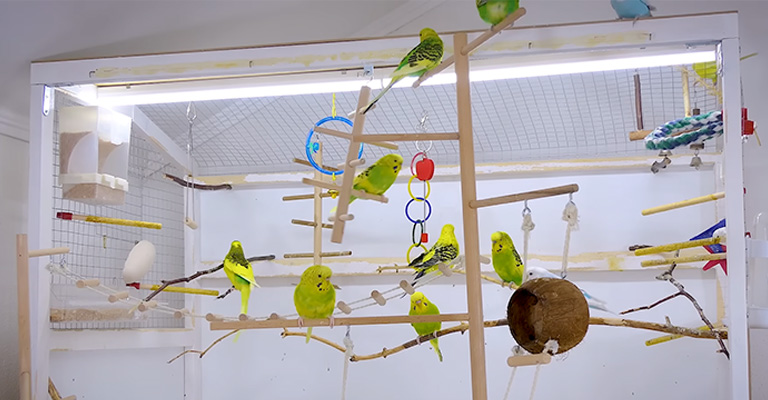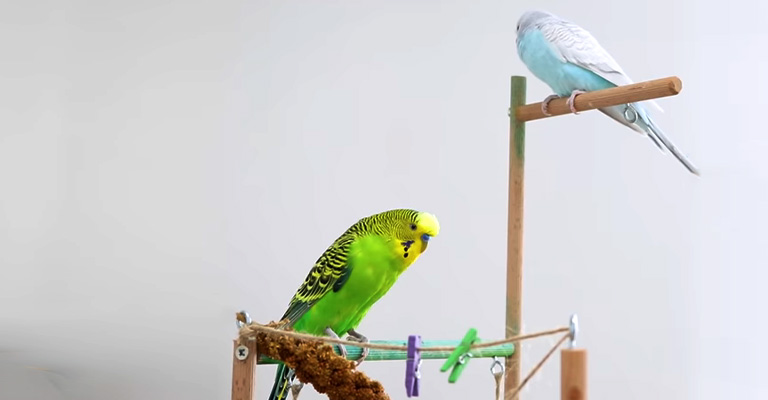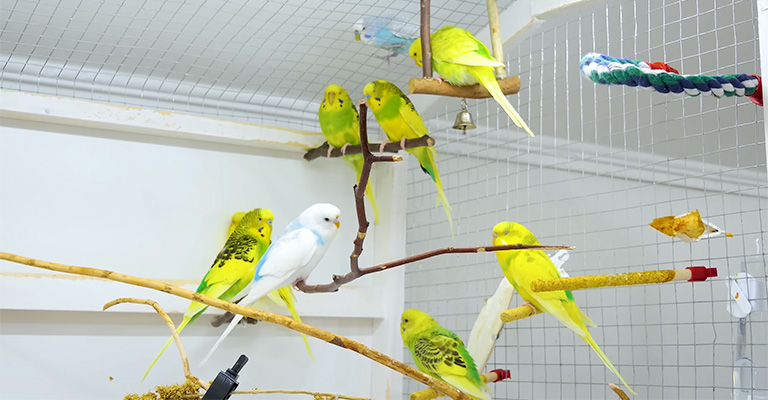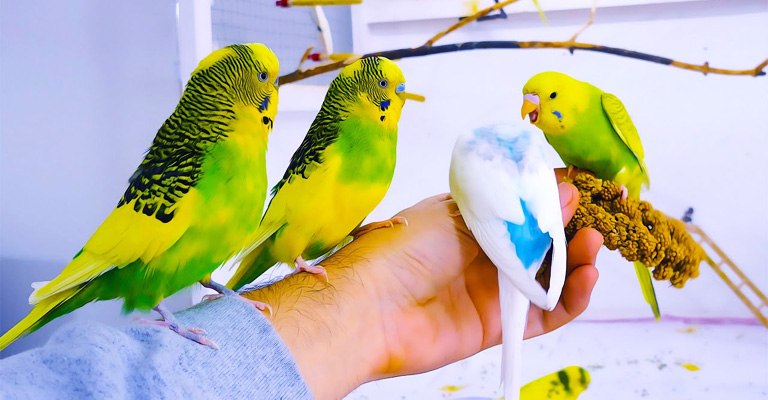Parakeets are beloved pet birds known for their vibrant colors and cheerful personalities. However, their enthusiastic squawking in the early morning can be a challenge for bird owners.
Realizing the reasons behind this behavior and finding effective ways to manage it can make a significant difference in creating a harmonious living space.
This article aims to shed light on the natural behavior of parakeets, the “dawn salute,” and provide practical solutions for reducing noise levels.
By implementing these strategies, bird owners can strike a balance between enjoying their feathery companions and maintaining a peaceful morning routine.

Parakeet’s Behavior in the Context of Being Louder in the Morning
To know why Parakeets are so loud in the morning, you need to understand their behavior in this context. Here are some of the facts to consider.
Social Nature
Parakeets, also known as budgerigars or budgies, are highly social animals. In the wild, they live in large flocks, constantly interacting and communicating with one another.
As a result, they have a strong need for social interaction and can become lonely or bored if left alone for extended periods.
Flock Dynamics
Within a parakeet flock, there is a hierarchical structure, with dominant and subordinate individuals. This social order helps maintain stability and ensures the overall well-being of the group.
As a pet owner, it’s important to understand this dynamic and provide appropriate socialization opportunities for your parakeet, including interaction with other birds or regular human interaction.
Vocalization

Parakeets are known for their chatty and expressive nature. They use vocalizations as a means of communication, expressing various emotions, needs, and warnings.
Different sounds, pitches, and rhythms convey different messages. It’s crucial to pay attention to your parakeet’s vocalizations to understand their mood and well-being.
For example, a high-pitched, rapid chirping may indicate excitement or contentment, while loud squawking can signal distress, fear, or the need for attention.
Mimicry and Learning
Parakeets are highly intelligent and capable of learning and mimicking sounds. They can imitate human speech, household noises, and even songs.
This ability to mimic is a natural behavior that enhances their social interactions within their flock and allows them to learn from their surroundings.
Engaging in regular training sessions and providing mental stimulation through toys, puzzles, or foraging activities can help keep their active minds stimulated and prevent boredom.
Diurnal Rhythm
Parakeets are diurnal, meaning they are most active during the day and sleep at night. Their natural rhythm is influenced by the rising and setting of the sun.
Therefore, it’s important to establish a consistent light-dark cycle by providing appropriate lighting and ensuring that their sleeping area is quiet and undisturbed during the night.
Instinctual Behaviors
Parakeets exhibit various instinctual behaviors, such as preening, foraging, and flock bonding. Understanding and accommodating these behaviors are crucial for their physical and mental well-being.
Providing a variety of toys, perches, and safe chewing materials can satisfy their natural instincts and prevent undesirable behaviors like feather plucking.
Solutions for Managing Parakeet Noise in the Morning

Managing parakeet noise in the morning can be a concern for bird owners who value a peaceful environment or live in close proximity to neighbors.
Fortunately, there are several solutions available to help minimize the noise levels and create a more comfortable living environment for both the parakeet and its owners.
Cage Cover
Using a blanket or specially designed cage cover to drape over the cage at night can create a dark and quiet environment for the bird.
This signals to the parakeet that it’s time to sleep and can help reduce noise levels in the morning. Make sure the cover is breathable and doesn’t restrict air circulation within the cage.
Fan or White Noise
The sound of a fan or white noise machine can create a calming background noise that helps mask the parakeet’s vocalizations.
This can be particularly effective in drowning out the morning squawks and creating a more peaceful atmosphere.
Ensure that the fan or white noise machine is placed at a safe distance from the cage to prevent any discomfort or drafts for the bird.
Eclipse Curtains
Using eclipse curtains in the room where the parakeet’s cage is located can block out both light and outside noise. These curtains are designed to create a dark environment, signaling to the bird that it is time to sleep.
Additionally, they can help minimize external disturbances, reducing the chances of the parakeet becoming overly vocal in response to outside stimuli.
Adjusting Sleep Schedule
With patience and consistency, you can gradually change the parakeet’s sleep schedule to align more closely with your desired waking time.
By gradually shifting the bird’s bedtime and wake-up time, you can train them to sleep later in the morning, reducing the likelihood of early-morning vocalizations.
Strategic Cage Placement
Consider placing the parakeet’s cage in a room where it won’t be exposed to external stimuli that may trigger excessive vocalizations.
Avoid placing the cage near windows or areas where other birds may be present. This can help minimize the bird’s response to external noises and reduce the overall noise levels.
Tips for Parakeet Owners

Here are some additional tips for parakeet owners to ensure the well-being and happiness of their feathered companions:
Provide Proper Socialization
Parakeets are social birds and thrive on interaction. Spend quality time with your parakeet every day, engaging in activities such as talking, singing, playing, and training.
This socialization helps prevent boredom, strengthens the bond between you and your bird, and can reduce excessive vocalizations.
Offer Mental Stimulation
Parakeets are intelligent birds that require mental stimulation to stay happy and healthy. Provide a variety of toys, puzzles, and foraging opportunities to keep their minds engaged.
Rotate and introduce new toys regularly to prevent boredom. Mental stimulation can help divert their attention and reduce excessive noise.
Maintain a Balanced Diet
Proper nutrition is crucial for the overall well-being of your parakeet. Offer a balanced diet that includes a variety of fresh fruits, vegetables, high-quality pellets, and occasional treats.
A nutritious diet can help keep your parakeet healthy and content, reducing stress-related vocalizations.
Create a Safe and Comfortable Environment
Ensure that your parakeet’s cage is spacious, clean, and equipped with appropriate perches, toys, and accessories. Provide a suitable temperature, proper ventilation, and access to natural light.
A comfortable environment promotes a sense of security and contentment, potentially reducing noise levels.
Seek Veterinary Care
Regular check-ups with an avian veterinarian are essential to monitor your parakeet’s health. Birds can exhibit excessive vocalizations or behavioral changes due to underlying medical issues. A vet can identify and address any health concerns that may contribute to increased noise levels.
Positive Reinforcement Training
Use positive reinforcement techniques to train your parakeet. Reward desired behaviors with treats, praise, or attention, and redirect undesirable behaviors gently.
Training sessions can help establish a clear communication channel between you and your bird, fostering a calmer and quieter environment.
Be Mindful of Environmental Triggers
Observe and identify any environmental triggers that may cause excessive vocalizations, such as loud noises, sudden movements, or changes in routine. Minimize or modify these triggers as much as possible to reduce stress and vocalization.
Consult a Bird Behavior Expert
If you’re experiencing persistent issues with excessive noise or vocalizations, consider seeking guidance from a bird behavior expert. They can provide personalized advice, training techniques, and additional strategies to address specific challenges.
Comparison of Solutions for Managing Parakeet Noise in the Morning
| Solution | Advantages | Disadvantages |
| Covering the cage with a blanket or thin sheet | Creates a dark and quiet environment for the bird, which can help to signal to the bird that it is time to sleep | May not be practical for all bird owners |
| Using a fan or white noise | Creates a calming environment for the bird, and can help to mask outside noise | May not be effective for all birds |
| Using eclipse curtains | Blocks out light and creates a dark environment, can help to block out outside noise | May not be practical for all bird owners |
| Changing the bird’s sleep schedule | Can be a long-term solution, can train the bird to sleep later in the morning | Takes time to adjust the bird’s schedule |
| Placing the cage in a room where they can’t hear other birds | Can be an effective solution, and can reduce outside noise | May not be practical for all bird owners |
FAQs
While it may be difficult to completely eliminate the “dawn salute” behavior, parakeets can be trained to be less vocal in the morning through consistent and patient training methods. By adjusting their sleep schedule, providing a dark and quiet environment, and using white noise or a fan to create a calming environment, the bird can be trained to reduce its noise levels in the morning.
Yes, it is safe to use a blanket or sheet to cover the cage at night as long as it is a breathable material and it does not impede the airflow in the cage. It’s important to make sure that the cover is not too tight and that the bird has enough space to move around and breathe comfortably.
While it may be helpful to have a separate room for the parakeet’s cage in order to reduce outside noise and create a quieter environment, it is not necessary. By using solutions such as a blanket or sheet to cover the cage, a fan or white noise, and eclipse curtains, you can create a dark and quiet environment for the bird in any room of your house.
Yes, parakeets can be trained to sleep later in the morning through consistent and patient training methods. By adjusting their sleep schedule gradually and providing a dark and quiet environment, the bird can be trained to sleep later in the morning and wake up later in the day.
Conclusion
By recognizing that this behavior is a natural instinct and part of their communication repertoire, bird owners can implement effective solutions to manage noise levels.
As you’ve seen, this article has highlighted various strategies such as using cage covers, employing fans or white noise, utilizing eclipse curtains, adjusting sleep schedules, and considering cage placement.
Additionally, the importance of patience, consistency, and recognizing that the issue lies with the environment rather than the bird itself has been emphasized.
You can create a peaceful and comfortable setting that respects the birds’ natural behavior and fosters a strong bond between human and avian companions by following the tips. Best of luck.